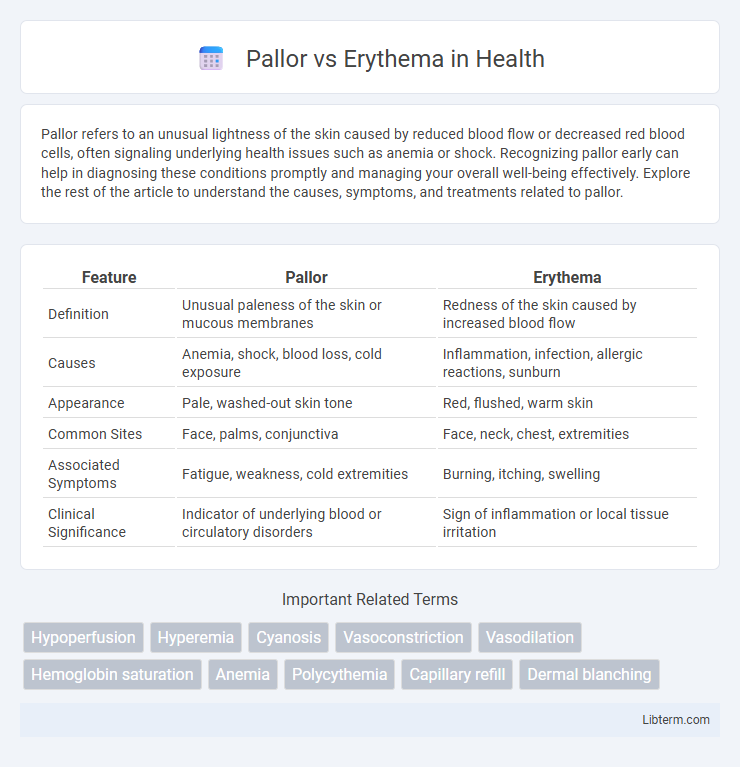Pallor refers to an unusual lightness of the skin caused by reduced blood flow or decreased red blood cells, often signaling underlying health issues such as anemia or shock. Recognizing pallor early can help in diagnosing these conditions promptly and managing your overall well-being effectively. Explore the rest of the article to understand the causes, symptoms, and treatments related to pallor.
Table of Comparison
| Feature | Pallor | Erythema |
|---|---|---|
| Definition | Unusual paleness of the skin or mucous membranes | Redness of the skin caused by increased blood flow |
| Causes | Anemia, shock, blood loss, cold exposure | Inflammation, infection, allergic reactions, sunburn |
| Appearance | Pale, washed-out skin tone | Red, flushed, warm skin |
| Common Sites | Face, palms, conjunctiva | Face, neck, chest, extremities |
| Associated Symptoms | Fatigue, weakness, cold extremities | Burning, itching, swelling |
| Clinical Significance | Indicator of underlying blood or circulatory disorders | Sign of inflammation or local tissue irritation |
Introduction to Pallor and Erythema
Pallor refers to an abnormal lightness or paleness of the skin caused by reduced blood flow or decreased oxygenation, often indicating conditions such as anemia or shock. Erythema is characterized by redness of the skin resulting from increased blood flow in superficial capillaries, commonly associated with inflammation, infection, or allergic reactions. Both pallor and erythema serve as important clinical signs reflecting underlying vascular or systemic disorders.
Definition of Pallor
Pallor is characterized by an abnormal paleness of the skin or mucous membranes due to reduced blood flow or decreased hemoglobin concentration, often indicating anemia or shock. Erythema, in contrast, refers to redness of the skin caused by increased blood flow, typically resulting from inflammation, infection, or irritation. Recognizing pallor helps in diagnosing conditions related to oxygen deficiency and poor circulation.
Definition of Erythema
Erythema is characterized by redness of the skin caused by increased blood flow to superficial capillaries, often resulting from inflammation, infection, or irritation. Pallor, in contrast, refers to an abnormal paleness of the skin caused by reduced blood flow or decreased red blood cell concentration. Understanding the distinction between erythema's redness and pallor's lack of color is crucial for clinical diagnosis and treatment.
Key Differences Between Pallor and Erythema
Pallor is characterized by an abnormal paleness of the skin, often resulting from reduced blood flow or decreased hemoglobin, while erythema presents as redness caused by increased blood circulation or inflammation. Pallor typically indicates conditions like anemia or shock, whereas erythema is associated with infections, allergic reactions, or sunburn. The primary distinction lies in their underlying vascular responses: pallor involves vasoconstriction or reduced blood volume, and erythema involves vasodilation or enhanced blood flow.
Causes of Pallor
Pallor is primarily caused by reduced blood flow or decreased hemoglobin levels, commonly seen in anemia, hypovolemia, or peripheral vasoconstriction due to cold exposure or shock. Other causes include chronic illnesses like chronic kidney disease or heart failure that impair oxygen delivery to tissues. Distinguishing pallor from erythema involves recognizing that erythema results from increased blood flow causing redness, whereas pallor results from diminished blood supply or oxygenation leading to paleness.
Causes of Erythema
Erythema results from increased blood flow to the skin caused by factors such as inflammation, infection, allergic reactions, or physical irritation like sunburn and trauma. Conditions including rosacea, cellulitis, and dermatitis frequently present with erythema due to vascular dilation and capillary congestion. Differentiating erythema from pallor is crucial, as pallor indicates reduced blood flow or decreased hemoglobin concentration, while erythema signifies hyperemia and localized redness.
Clinical Presentation: Identifying Pallor
Pallor presents as an abnormal lightening of the skin and mucous membranes, often indicating reduced blood flow or decreased hemoglobin concentration. Clinically, it is most noticeable in areas with thin skin such as the conjunctiva, lips, and nail beds, where the usual pink or red coloration fades to a pale or whitish hue. Unlike erythema, which manifests as redness due to increased blood flow or inflammation, pallor is characterized by a lack of normal redness and may suggest underlying conditions like anemia or shock.
Clinical Presentation: Recognizing Erythema
Erythema presents as localized or widespread redness of the skin caused by increased blood flow in superficial capillaries, often accompanied by warmth and sometimes swelling. Clinically, this redness is blanchable under pressure, differentiating it from purpura or petechiae, and may be linked to inflammation, infection, or allergic reactions. Recognizing erythema involves assessing its distribution, associated symptoms, and potential triggers to distinguish it from pallor, which indicates reduced blood flow or oxygenation and appears as pale, ash-colored skin.
Diagnostic Approaches for Pallor and Erythema
Diagnostic approaches for pallor include clinical examination assessing skin, mucous membranes, and conjunctivae color, often supplemented with complete blood count (CBC) to evaluate anemia or hypoxia. Erythema diagnosis involves visual inspection of the affected skin regions for redness, warmth, and swelling, with dermoscopy and skin biopsy aiding in distinguishing inflammatory or infectious causes. Laboratory tests, such as C-reactive protein and erythrocyte sedimentation rate, help confirm underlying systemic inflammation linked to erythema.
Treatment and Management Strategies
Pallor treatment focuses on addressing underlying causes such as anemia or shock through blood transfusions, iron supplements, or intravenous fluids to restore normal blood flow and oxygenation. Erythema management involves treating the root cause, which may include anti-inflammatory medications, corticosteroids, or antihistamines for allergic reactions and skin infections, alongside avoiding known irritants. Both conditions require accurate diagnosis and targeted therapy to prevent complications and promote skin health recovery.
Pallor Infographic

 libterm.com
libterm.com